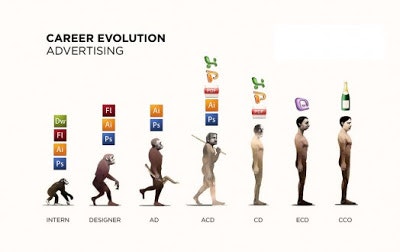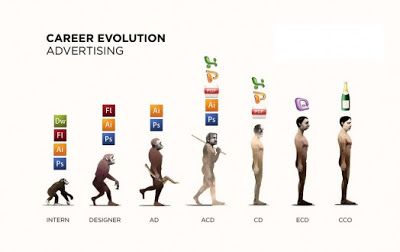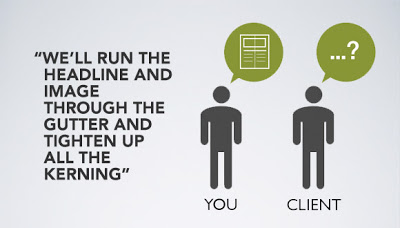Presenting Creative 101 ' Part 1: What are we presenting?


Throughout my career I have consistently been given high praise for being really good at presenting creative and it didn't happen by accident. Early on I realized that my design skills were only going to take me so far if I wasn't able to sell my work. The problem was that I left college afraid to talk in front of a group and hadn't been given any tools to sell my work. I needed to get over my fear, understand hot to sell and the psychology of it all. I started to hanging around with people who sell to high end clients for a living like venture capitalists, sports agents and PR agents to study their techniques. I even went so far as to read police interrogation books to understand how to analyze people and what makes people tick . It may sound really extreme but like I said this wasn't anything I was taught in art school so I had to make up my own curriculum. Like the illustration above points out , the further you go in your career the further you are going to get away from you brought you into it. You are going to be doing less design work and the more budgets and presentations.
As I traveled around and worked with other creatives from all over the world who graduated from the best design school I heard that they had the same problem. So I wanted to share what I have learned with a broader audience in the hopes that it can help you too. It normally takes me about an hour and half to do this starter class so I am going to break it into three articles and try to keep the points short and to the point. This first article looks at the core to any great presentation and what we are really selling. Then in the second article we will go over the set-up to the presentation and the presentation itself. Finally we will look at how to handle problem clients and dealing the aftermath of the presentation. I hope this helps, please share what I have learned and if you would like me to present the full class at your conference drop me a line.
EVERYONE PRESENTS CREATIVE
The first thing that EVERYONE from the designers to the project managers and everyone in between needs to realize is that everyone in the creative team presents creative. Even if they aren't pitching concepts or showing comps they present their work and the core principle listed here work for everyone on the team because all the pieces of a project are linked together.
PRESENTING = SELLING
Present spreadsheets. Sell creative.
Once you get everyone to understand that this is a part of the core DNA of any creative group then you need to change the way you think about presenting because what we are really doing is selling. If you have the results of an ad campaign from last quarter then you present it to the client but when you have a new project you are trying to make someone BUY something. Making someone buy something takes a totally different way of thinking from presenting.
SELLING CONFIDENCE NOT COMPS
So we are selling not presenting but what is it we are really selling? Comps? Concepts? Sorry but none of the above. We are selling trust and confidence. Unlike a car salesman who will let you sit in the car and take it for a test drive, we are selling air. We are selling the idea of something we want to make. Something we think will move people. Something we can roughly sketch up but wont be able to really show you in a finished form until we go on that photo shoot with the high price tag you're going to find at the end of the presentation. So you, the client, need to trust that I know what I am doing. You need to trust that this is a great idea. You need to trust that the future of your career is safe in my hands and I am going to make you look like a hero at the end of all of this. Without that the best idea in the world will never see the light of day and will never make a difference to anyone.
HOW DO YOU SELL TRUST & CONFIDENCE?
Selling confidence sounds simple enough when you say it out loud but I have spent most of my career trying to perfect the process and it is a skill you will have to constantly evolve and adapt to meet the challenges of new projects and new clients. Here are some of the big things you need to do and be aware of to build trust with your clients.
ONE VOICE
Everyone needs to support each other no matter what
Selling creative and conveying confidence are a team concept. As you go through a project a client will interact with a lot of different team members and anyone one of them can break that confidence and throw a project into problems and changes in a heart beat. Problems and disagreements will happen but they need to be worked out behind the scenes. You need to speak with one voice on every presentation and cast doubt on what someone is saying or presenting so your client gets confidence from seeing a team that is completely behind one concept.
SHORT TERM MEMORY LOSS IN THE IVORY TOWER
Look at your work with fresh eyes so you can sell it
When you work on a project for a long time you get immersed in the details and problems which is a natural part of the creative process. When it comes time to finally present that work to the client you need to be able to develop the ability to remove yourself from that forrest of details and problems to be able to see the project with fresh eyes. To get short term memory loss so you don't skip over key details and selling points, assume the client knows thing they don't and, most importantly, you won't do justice to all the hard work your team put into the project.. It is critical to be able to see how to present the work in a clean and simple way to someone who knows nothing about it so they can understand it and have confidence that it will work.
NOT EVERYONE CAN SEE IT
Don't assume clients can see creative the same way you can
Working in digital I have been in a lot of meetings where co-workers use terms they know the client won't understand to sound cool. The problem is that you may think you sounded cool but you probably just lost the connection with your client, made them feel self conscious for not being in the know and none of that leads them to feel confident about you or the work. You need to realize that not everyone has the ability to see designs in their minds eye the way that we can so you have to take that into consideration when you talk. Be overly descriptive or sketch the solution on the back of a piece of paper so everyone can see it. This will also help eliminate any confusion and those dreaded words from your client at the next meeting ' 'Oh' That wasn't what I had in my head after our last meeting'.
Also realize that coming out of any presentation your work will probably be re-presented and it won't be done by you. I always want to be confident that when my client leaves a meeting with me to go back to their office to show off the work to their boss they will be able to talk about it confidently because they understand all the details that went into it. If I talk over their head then that next presentation isn't going to go well and the project could be sidetracked before it even got started.
EVERYTHING COMMU
NICATES
You aren't just selling your work with your words
Think about the fact that when you are presenting you are communicating with more than your words and that your body language and tone can say just as much. Doing things like slumping down in your chair, looking off into space or having an ambivalent tone about your work all subconsciously communicate a lack of confidence in what you are presenting. Think of it like a poker game and your client is subconsciously looking for tells about what you are really thinking.
PASSION & AUTHENTICITY
It's OK to love your work
When it comes to creative the TV and movie generated idea of a slick person standing at the front of the behind a podium delivering the information in clear monotone can really hurt them. You were asked to create something out of nothing and that process should have infused the final result with elements that mean something to you. You aren't presenting spreadsheets so have some passion about the work and let your client see it. Saying simple things like 'I really love this idea' will let them know that you believe in the work. It will let me know you are going to bring this to life with the same passion you had when you created it. It will give them confidence that you have something invested in the project and that it means more to you and your team than just another assignment.
EMOTIONAL FOCUS
Go to your happy place
From the time I was around 8 years old though high school I shot competitive archery at a near Olympic level. It's a sport of control and repetition that becomes a head game because it all about you. There is no team to jump on a mistake and save you. You win and you get all the glory. You lose and there is no one to blame but yourself. As a part of my training I had a coach who drilled it into my head that in high pressure situations nervousness is a self created emotion. When you need to make a shot your emotions are completely in your control.
Standing in front of a room full of clients needing to sell them on your concept can be intimidating. Anytime I need to deliver in a big meeting or present at a big conference I get nervous. It's a natural reaction. The key is be aware that this is going to happen, that it is OK if it does and try to develop things to help you deal with it. For some people it is practicing the presentation until they know it forwards and backwards so they can go on autopilot. For other people it is finding comfort in going about the presentation in a ritualistic way so they find comfort and control in going through familiar ordered actions. For me it is finding a quiet place a few minutes before I need to present to sit down, close my eyes and think about something that makes me happy. It is usually something outside of work and away from whatever it is I am about to go do. Something that helps me get myself centered, clear my head and my nerves. This should be different for everyone since your personal triggers are going to be different.
All of this is just the beginning and like I said I will be moving on to the set-up for the presentation and the presentation itself in the next few days before ending with how to handle problem clients and dealing the aftermath of the presentation.